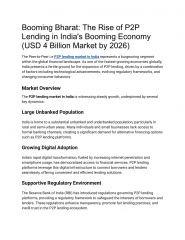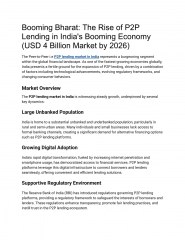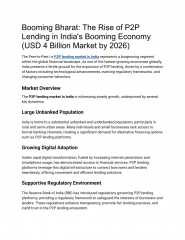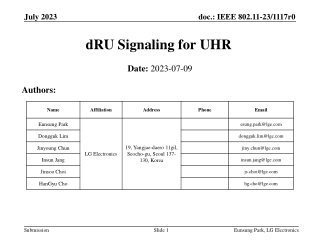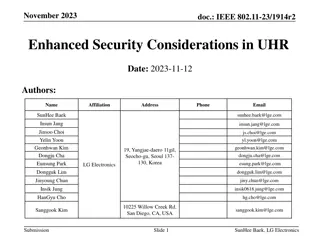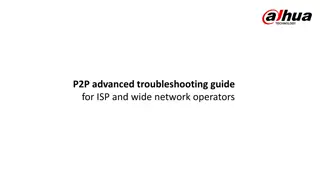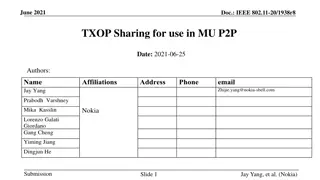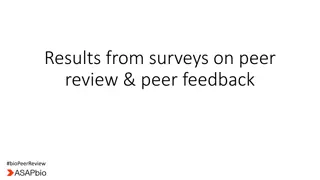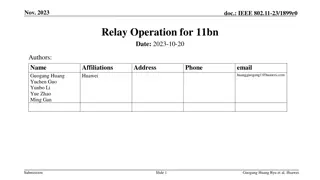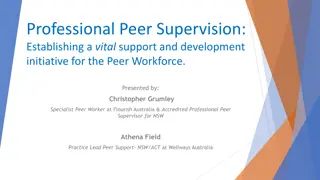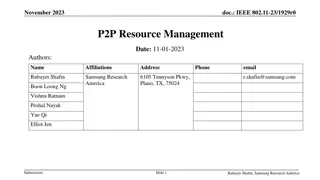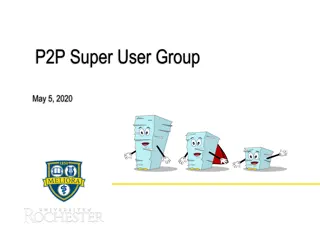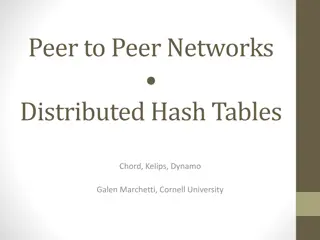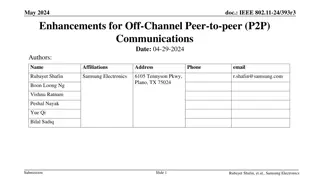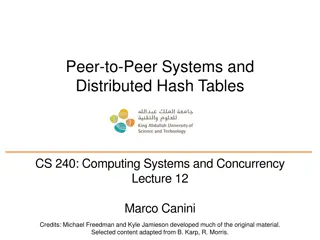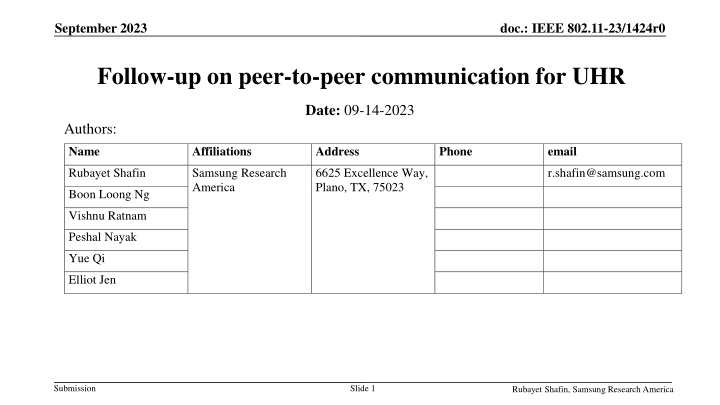
Improving Peer-to-Peer Communication in UHR: Key Insights and Recommendations
Explore the advancements in peer-to-peer communication within the context of UHR technology as discussed in the September 2023 IEEE document. The document delves into the extension of Channel Usage procedures to enhance P2P support, emphasizing the benefits of recommended P2P channels and transmission windows. Discover the motivations for both APs and P2P STAs to adhere to these recommendations, ultimately optimizing network performance and efficiency.
Download Presentation

Please find below an Image/Link to download the presentation.
The content on the website is provided AS IS for your information and personal use only. It may not be sold, licensed, or shared on other websites without obtaining consent from the author. If you encounter any issues during the download, it is possible that the publisher has removed the file from their server.
You are allowed to download the files provided on this website for personal or commercial use, subject to the condition that they are used lawfully. All files are the property of their respective owners.
The content on the website is provided AS IS for your information and personal use only. It may not be sold, licensed, or shared on other websites without obtaining consent from the author.
E N D
Presentation Transcript
September 2023 doc.: IEEE 802.11-23/1424r0 Follow-up on peer-to-peer communication for UHR Date: 09-14-2023 Authors: Name Affiliations Address Phone email Rubayet Shafin Samsung Research America 6625 Excellence Way, Plano, TX, 75023 r.shafin@samsung.com Boon Loong Ng Vishnu Ratnam Peshal Nayak Yue Qi Elliot Jen Submission Slide 1 Rubayet Shafin, Samsung Research America
September 2023 doc.: IEEE 802.11-23/1424r0 Abstract In [1],[2], we highlighted some of the potential technologies for improved peer-to-peer (P2P) operation. Extension of the Channel Usage procedure was identified for improving P2P support in UHR[3] In this contribution, we provide some details and extensions for [3] Submission Slide 2 Rubayet Shafin, Samsung Research America
September 2023 doc.: IEEE 802.11-23/1424r0 Recap (1/2) Advertisement of Recommended P2P Channels An AP can announce a set of channels in its BSS that are recommended for P2P communications These advertised channels would be more conducive to P2P communication. For example, the AP can minimize the use of those channels for its infrastructure communication. The AP can announce/advertise the Recommended P2P Channels in its BSS by including the related information in the Beacons and Probe Response frames it transmits. For example, the AP can include Channel Usage elements for this advertisement The P2P channel recommendation can be updated over time. Motivation for the AP: By incentivizing the P2P STAs to keep their P2P transmissions within the recommended set of channels, the AP can essentially reduce the uncontrolled P2P transmission on the channels that the AP uses for infrastructure BSS operation (for UL/DL communication, for example) This, in essence, can help the AP in ensuring infrastructure STAs QoS requirements. Motivation for the P2P STAs: The guidance from the AP would enable the P2P STAs to embark on a cleaner channel (with less interference from the infrastructure) faster for their P2P communications by using the recommended channels Help faster setup of a P2P link (or P2P group) Help faster switch of a P2P operating channel Submission Slide 3 Rubayet Shafin, Samsung Research America
September 2023 doc.: IEEE 802.11-23/1424r0 Recap (2/2) Advertisement of Recommended P2P Transmission Windows Similarly, an AP can announce a set of recommended time windows that would be more conducive for P2P transmission. During these recommended P2P Transmission Windows, the AP can minimize infrastructure transmission Motivation for AP: Reduces non-infrastructure transmission outside these P2P Transmission Windows and improves the manageability of the network. Motivation for P2P STAs: Thus provides incentives for the P2P STAs to use the P2P transmission windows for their P2P communication and encounter less interference from the infrastructure communication The AP can announce a series of recommended P2P Transmission Windows in the Beacon and Probe Response frames Existing signaling tools (e.g. TWT) can be reused for this purpose. annoucement Beacon P2P transmission window P2P transmission window P2P transmission window P2P transmission window AP Submission Slide 4 Rubayet Shafin, Samsung Research America
September 2023 doc.: IEEE 802.11-23/1424r0 Need for extended support (1/2) The P2P STAs can follow the P2P channel resource recommendation from the AP for their P2P needs. AP2 AP1 STA1 This helps in parking on a channel for P2P that would have less interference from the BSS maintained by that AP. P2P STA4 STA3 STA2 However, in an OBSS environment, the P2P link is still likely to face interference from the OBSS network P2P channel recommendation from the first AP may be independent of the recommendation from the OBSS AP. BSS2 BSS1 The P2P link between STA1 and STA2 follows the channel recommendation from AP1 but still suffers from interference from BSS2. Submission Slide 5 Rubayet Shafin, Samsung Research America
September 2023 doc.: IEEE 802.11-23/1424r0 Need for extended support (2/2) It is becoming a common scenario where two P2P STA are associated with different infrastructure APs. AP1 AP2 It s challenging to maintain both the UL/DL and P2P flows in such situations If in the respective base-channels (i.e. APs channels), hard to schedule the P2P sessions. Troublesome for LL traffic. If trying to go off-channel, hard to find a common off-channel they are clean from both infrastructure networks. P2P STA1 STA2 STA1 is associated with AP1; STA2 is associated with AP2; STA1 and STA2 forms a P2P link (not TDLS). Submission Slide 6 Rubayet Shafin, Samsung Research America
September 2023 doc.: IEEE 802.11-23/1424r0 Multi-AP Coordination for channel usage enhancements (1/2) For efficient P2P communication, it would be good if the APs corresponding to the overlapping BSS coordinate with each other. Upon coordination-- The APs can designate a common set of channels for P2P Help facilitate off-channel P2P operation AP2 AP1 STA1 P2P STA4 The APs can create a common schedule for P2P Help facilitate base-channel P2P operation STA3 STA2 BSS2 BSS1 Submission Slide 7 Rubayet Shafin, Samsung Research America
September 2023 doc.: IEEE 802.11-23/1424r0 Multi-AP Coordination for channel usage enhancements (2/2) After negotiation, the participating APs can advertise the P2P channel resources. The advertisement can be either only on channel guidance or only on schedule guidance or both P2P Ch. 3 P2P Ch. 3 P2P channel Negotiation Req. Beacon P2P Ch. 2 P2P Ch. 2 P2P Ch. 1 P2P Ch. 1 AP1 TWT for P2P TWT for P2P P2P Ch. 3 P2P Ch. 3 P2P channel Negotiation Resp. Beacon P2P Ch. 2 P2P Ch. 2 P2P Ch. 1 P2P Ch. 1 AP2 TWT for P2P TWT for P2P MAP negotiation phase. TBD Submission Slide 8 Rubayet Shafin, Samsung Research America
September 2023 doc.: IEEE 802.11-23/1424r0 Summary Tighter coordination between the infrastructure and P2P networks would be important to ensure QoS support for WLAN systems. In this presentation, we extend the contribution [3] on channel usage to multi-AP coordination framework. Facilitates improved QoS for P2P communications Submission Slide 9 Rubayet Shafin, Samsung Research America
September 2023 doc.: IEEE 802.11-23/1424r0 References [1] IEEE 802.11-22/1528r1, Enhanced Device Connectivity with Robust QoS Support , R. Shafin et.al., Sept 2022. [2] IEEE 802.11-22/932r0, Thoughts on Beyond 802.11be , W.B. Lee et.al., July 2022. [3] IEEE 802.11-23/294r1, Channel Usage Enhancements for P2P in UHR , R. Shafin et.al., May 2023. Submission Slide 10 Rubayet Shafin, Samsung Research America

